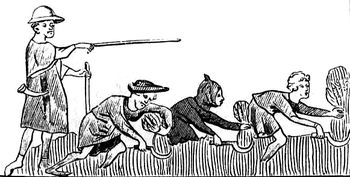 | Land usage in Ewyas Lacy has varied considerably as farming practices and social patterns have evolved over the centuries. There is little documented evidence of these matters prior to the 16th century, but despite the recurring conflicts that swept the Marches and periodically drove the peasantry off the land, it is probable that the general feudal pattern of subsistence farming was prevalent in those days. This would have involved limited cultivation of crops [mainly corn for human consumption], extensive meadows and pastures for grazing, areas of shared common land, unused 'waste' land, woodlands for timber and coppicing and 'forests' reserved as hunting grounds for the aristocracy.
|
The 16th,17th and 18th centuries saw an agricultural revolution take place in England. Initially the growth of the wool trade led to more intensive livestock farming and to the widespread enclosure of land, including commons, for that purpose. This drove many people off the land, while by the 18th century the emerging industrial revolution was creating the foundations for a wage based economy and a new demand for farm produce to feed the urban masses. This in turn coincided with the development of new machinery and techniques that radically improved agricultural productivity. These events transformed farming from the traditional subsistence activity to a profit-orientated commercial business and gave new impetus to crop cultivation within mixed farms. Land became even more valuable, and enclosures accelerated, absorbing the old forests, wastes and most of the commons into new, larger farms.
The wealth from this 'agricultural capitalism' showed itself in the 19th century in the creation of large mansions and landscaped country estates by the landowning gentry and wealthy incomers; sale particulars of the time are a valuable source of detailed information on land usage. These estates often had their roots in ancient feudal rights of tenure, and allowed the rich to enjoy elegant lifestyles until the World Wars and social/economic upheavals of the 20th century largely put paid to this way of life.
|  |
|





